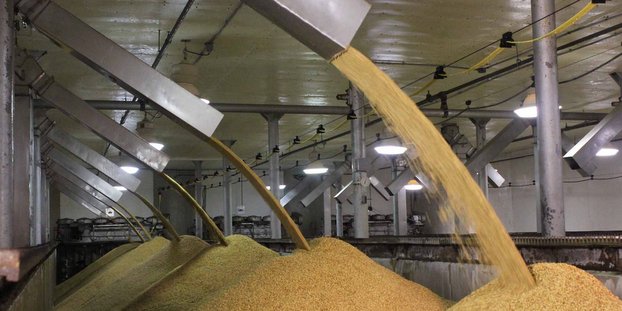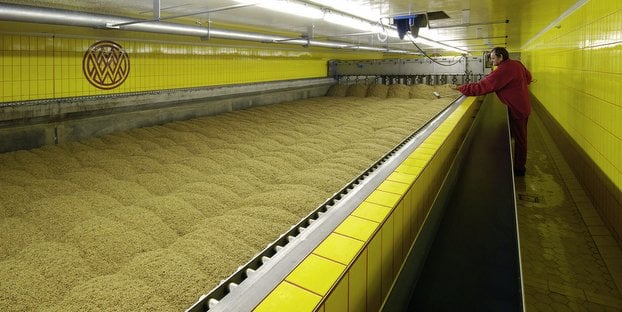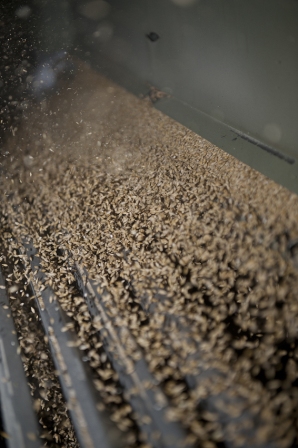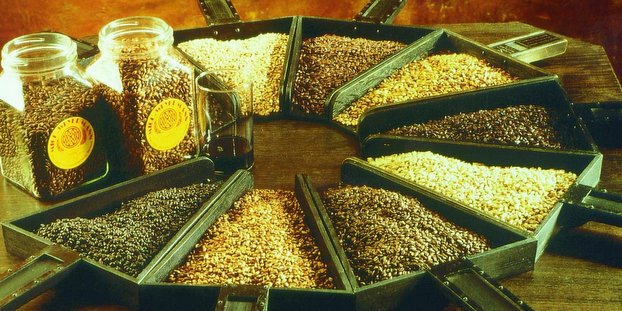
Water, barley, hops and yeast. That’s the magical elixir of beer brewed down to its simplest form. But like many brews in the craft beer industry, brewers aren’t content with just any run-of-the-mill malted barley. Craft brewers often demand quality and variety in their malt selections.
“Fifty years ago, the only specialty malts being made in the U.S. were produced by Briess. Today, American craft brewers have a dizzying array of domestic and imported specialty malts available to them. So craft beer’s demand for variety, special packaging/grain handling systems and technical support from their malt supplier have greatly impacted the malt industry,” said Bob O’Connell, vice president of sales and marketing for Briess Malt & Ingredients Co., a family-owned malting company that puts the focus on producing a vast offering of specialty malt styles based in Chilton, Wis. “Craft brewers are constantly asking us, ‘What’s new?’ They need a large malt toolkit at their disposal to create a constantly changing beer menu. The amount of malt they need will increase as their businesses grows, but the real demand is for variety and new malts with unique flavors and styles.”
While the demand for specialty malts grows, commodity base malts still make up the lion’s share of the U.S. malt industry in terms of volume. But the malt industry has spent the last 40 years adding specialized drying equipment and other capital improvements to produce specialty malts for small scale craft beer production, O’Connell explained.
As the craft beer industry continues to grow, swelling with new brewers and demand for specialty malts spread over a wide variety of options, it’s important for brewers to establish a solid relationship with a malt supplier and plan as much as possible when ordering their malt supply.
Malted insight
Like any agricultural product, the availability of malted barley can be impacted by a wide range of weather and economic factors, both locally and globally.
“Barley is the world’s fourth-most common grain, after corn, rice and wheat and before sorghum, and the malting industry is not the world’s largest consumer of barley,” said Sabine Weyermann, CEO of Weyermann® Malting Co. Based in Bamberg, Germany, Sabine is the fourth generation of Weyermann, great granddaughter of company founder Johann Baptist Weyermann. “Most barley is used as animal feed and human food. In the food industry, barley can become pearl barley, a breakfast cereal, or flour. While there are easy substitutes for many barley uses, especially in the feed markets, maltsters really cannot replace barley with other grains, nor can they lower their quality standards at times when barley stocks are becoming tight in the commodity markets. Therefore, maltsters are always in competition with other industries for their key commodity.”
Competition for barley is fierce across the globe and markets for the crop are tightening because of the dramatic growth in the world’s population, the accelerating frequency of weather catastrophes as a result of climate change, the use of barley as a makeup crop for periodic shortfalls in many other agricultural commodities and the often politically encouraged acreage shift from feed and food crops to biofuel crops. As a result, the use of barley for feed and other industrial uses has almost doubled in the past three years, while the use for food and related uses, including beer-making, has remained virtually unchanged, according to Weyermann.

In the United States, factors like a lack of federal farm aid for crop failures, competition from corn and wheat and declining malt use by large breweries has resulted in a decline in barley acreage over the past 20 years. And only a small portion of barley grown is malting barley.
“All of this has made malting barley an extremely niche crop,” O’Connell said. “About 80 percent of our customers now contract for their malt needs. Less than 10 years ago that was unheard of.”
Jeff Milligan has seen similar malt trends develop. Milligan is the North American Commercial Manager of Malt at Cargill, a Minneapolis-based company with a worldwide malt network that includes malting facilities in strategic proximity to the premier barley-growing regions in Europe and the Americas, as well as a relationship with Dingeman’s fine Belgian malts. “The single largest challenge comes from trends in decreased acres in planted barley due to competition from other crops such as corn, soy and wheat. The grower may get a better return on these and other crops in many geographies.”
This is all before demand from large and small brewers pull on the ebb and flow of malt availability. While the agricultural product has its share of challenges, this is not to say that it’s doom and gloom in the malt industry. Craft brewers are helping to grow the malt industry by demanding better quality and wider availability of specialty malts.
“Historically, the craft brewers believed that they were getting ‘what was left’ after the big brewers were done. Now, they are driving improvements in quality and focusing maltsters on different quality parameters,” Milligan explained. “In the end, the needs of the craft brewers are driving innovation in malting and even influencing grower behaviors around the needs for different varieties of barley. Craft brewers will continue to play an increasingly important role in the barley and malting worlds.”
Supplier demand
Brewers know that the quality of their product is linked to the quality of their ingredients. It’s the same for maltsters. You can’t make a high-quality beer out of low-quality ingredients, and you can’t make high-quality malt out of low-quality barley. For brewers, this means finding a quality maltster and supplier.

“The quality of a brewer’s beer starts with the quality of the farmer who works the barley field. It starts with deep plowing, with the judicious and minimum use of herbicide and pesticides, the timing of planting and harvesting decisions, the treatment of the grain in the storage silos, the maltster’s expertise in guiding the grain through the steeping, germinating, stewing, kilning and roasting steps, the quality of the packaging systems and the overall cleanliness of the facility,” Weyermann said, emphasizing the importance of the maltster/brewer relationship. “Visit your maltster, even if overseas. Make an audit of the facility. Even get to know the growers that supply the raw materials. Find out about the maltster’s incoming inspection standards. Check out the hygienic standards of your malt source. Entrust the quality of your beer only to a maltster you can trust.”
All relationships are built on a foundation of trust. As a brewer, you have to know what to look for in order to open up and start building a partnership with a maltster. Milligan recommended that brewers make sure to buy from a reputable supplier with a good history.
“There are many small players coming onto the market that provide a niche, but may not be able to provide the analytical support for the malt they provide,” he said. “The truth is in the analytics, but trust what you see in the brewhouse when you trial the malt. Ask questions and challenge us to be better.”
As a small maltster, Briess puts the focus on its history, starting as a Czechoslovakian malthouse in 1876 and its evolution into a small-scale, hand-crafted specialty malt producer. “Many malting companies have since entered the United States specialty malt industry as craft beer succeeded,” O’Connell said. “We maintain a true passion for malting, brewing and the American craft beer culture and believe that producing superior malts and partnering with brewers to help solve their challenges and growing pains are essential qualities that brewers should receive from their malt supplier.”
As a brewer, not only are you searching for a quality product, but also quality service, solutions, technical support, supply chain and ease of doing business.
“Consider the freshness of the malt, promptness of deliveries, reliability of distribution, quality guarantees, valid certifications, portfolio variety for innovation and experimentation and, most importantly, consistency of performance of each malt shipment in the brewhouse and in the fermenters,” Weyermann emphasized. “If the proof of the pudding is in the eating, the proof of the malt is in the beer drinking.”
When you’ve found your malt match made in heaven, it’s time to place your orders. Typically, that decision is determined strictly by the quantity — both in present and future brewing plans.

“Brewers should consider ordering their base malts on a bulk basis, but it’s really a function of cost and handling,” Milligan said. “Each brewery will have a breakpoint where it makes sense to invest in a silo and receive bulk malt. Brewers will typically get discounts for ordering in larger quantity and Cargill offers silo financing options to support craft brewers as well. In general, as a brewer grows, they should be asking their maltster to provide larger packaging to improve their cost structure. Then it’s a trade-off between capital, gross investment, inventory turns, etc., balanced with flat pricing of the raw material.”
As Milligan pointed out, adding silos is not a blanket decision. It comes down to the size and demands of your brewery. Weyermann explained that even some large brewers do not necessarily benefit from a having their own silo. “Instead, they can take advantage of our one-metric-ton BigBags,” she said. “They provide flexibility, efficiency and product freshness. We can even custom-blend grain bills for different beer recipes and deliver them pre-mixed in BigBags for milling on location right before mashing.”
On a brew-by-brew basis, 2,000-pound super sacks, in O’Connell’s experience, are not an uncommon option, especially for one-offs, seasonals and other special brews.
“Seasonals are probably the number one reason [for sack orders], especially if they want the malt blended and shipped in a super sack which saves them a great deal of labor, time and discarding of empty bags,” he said. “Milling challenges are another reason some brewers order malt for a specific brew. It’s often easier to order a pre-ground malt, especially when a variety of specialties are used in a brew, to save the time and hassle of changing mill settings.”
Clearly, there are many options, but since you’ve found a malt supplier you trust, you should be able to work with them to craft a solution that perfectly fits your unique brewery demands. After all, working together is the best way to grow your brewery’s bottom line and the industry as a whole.
“It’s not every day that suppliers play such a significant role in helping a new industry take root … but it’s meaningless if that initial spirit and passion fades,” O’Connell said. “I have to say I’m very impressed with the intense dedication that this company maintains for malting and the American craft beer industry. Craft beer is experiencing phenomenal growth, and we wish all breweries success.”





chaussures tn requin pas cher says
figurent ainsi parmi les petits papiers Twitter du locataire de la Maison-Blanche.g
Master maltsters reveal how to strengthen your malt supply chain @CraftBrewingBiz http://t.co/JdaYkZyaCj
Master maltsters reveal how to strengthen your malt supply chain http://t.co/p0qanvdvsZ #craftbeer #beer #TxBeer
RT @ithinkaboutbeer: #FarmToGlass it’s important! RT @CraftBrewingBiz Master Maltsters: Strengthening your malt supply chain http://t.co/kY…
#FarmToGlass it’s important! RT @CraftBrewingBiz Master Maltsters: Strengthening your malt supply chain http://t.co/kYWLuBHQUZ #CraftBeer